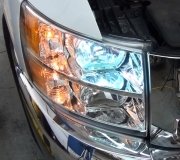Electronic flashers always flash much too fast when not enough current is flowing. Not enough current is caused by a burned out bulb or one that has a broken current path, meaning a break in the wire going to a bulb or going from a bulb to ground, (the body).
To save money, the ground wires for all of the bulbs in one corner of the car tie together in a single terminal that is bolted to the body sheet metal. What can happen when that ground terminal is loose, disconnected, or corroded, is current from one circuit goes through its light bulb, can't find its ground return path, and flows through a different bulb, then to its mate on the other side of the car and through ITS ground.
The clue to this problem that's staring you in the face is your observation of the signal indicator light on the dash lighting up when you turn on the head lights. Of course you've never had this problem before, but millions of other people have.
General Motors has really managed to mess up and complicate a previously simple circuit with their insane daytime running lamp design but you might find the following clues to be helpful. You should find the right head light is not as bright as the left one. Current flows through the right low beam, can't get to ground the normal way, so it goes through the attached high beam, over to the other side of the car, through that high beam and to its ground. Since current has to go through three filaments, current is cut to one third of normal so the right bulb is dim. On normal cars, you can prove this by unplugging the left head light socket. If the right head light goes off, it has a bad ground. This might not work on GM cars because of the messed up way the lights are wired, and they use a computer to run the high beams at 80 percent for their daytime running lights. This test might work if you manually turn on the head lights or apply the parking brake to turn the DRL off.
The second clue is current going to the right running lamp can't get to ground either so it looks for an alternate path. It finds one through the attached turn signal bulb. Some current goes through the signal bulb on the left side, then to ITS ground, and some goes through the signal indicator on the dash then through ITS ground. Since it's going through more things than normal, you'll see the dash indicator is not full brightness.
Start by turning on the head lights, then walking around the car and comparing the brightness of each light on both sides. On the right side, on the front or rear, the signal bulb will be on dim along with the running light that is also dim, but the two together can make it look like the running light is normal brightness.
Next, turn everything off, then just turn on the four-way hazard flashers, then compare the lamp brightness, front and rear. You're going to see something different between the left and right sides. Once you determine if the problem is in the front or rear, that's the place to follow the ground wire to look for the break.
Friday, January 6th, 2012 AT 10:09 PM


